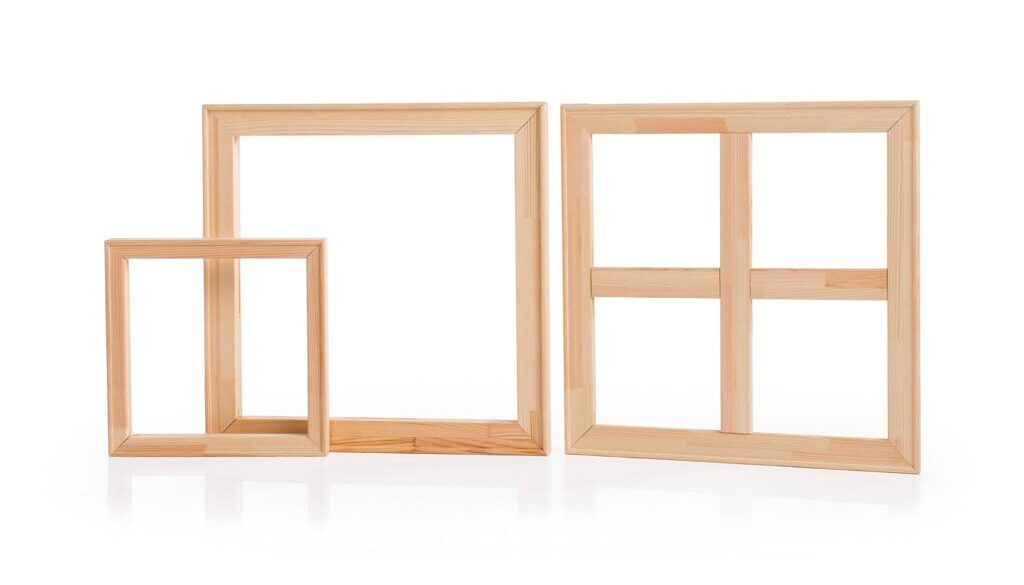Best wood for canvas stretcher bars
In order to ensure the longevity of the canvas and the art it showcases, it is important to choose what material the canvas frame is made of. There are several options what to choose from. What kind of wood should the stretcher bars be made of—spruce, pine, aspen? Should the canvas stretcher bars be glulam, finger-jointed or both? In this guide we’ll give you some recommendations, what to keep in mind while choosing the right wood for your stretcher bars.
What type of wood to choose for your canvas stretcher bars?
There are several types of wood from which stretcher bars can be made from.
Pine or spruce is the most common choice to make if you want your stretcher bars to be made from softwood.
Pine (redwood) stretcher bars
Stretcher bars made from pine are lightweight, durable and strong. Pine is known for its excellent work-ability. It can be easily cut, shaped and milled, making it a practical choice for canvas stretcher bars. The bars will not crack or splinter as easy. Pine is also widely available and has excellent quality-price ratio. But careful handling is necessary when working with pine. Compared to hardwood canvas stretcher bars, bars made from pine are softer and they need to be handled with consideration to avoid dents and scratchers in the frame.
Spruce stretcher bars
Similar to stretcher bars made from pine, spruce bars are also lightweight. Spruce is cheaper than pine and has the same availability. Compared to pine, spruce is an even softer wood and it is prone to denting and scratching. Spruce stretcher bars are not as heavy-duty as pine bars and they tend to wear out faster. When it comes to looks spruce typically has a straight and uniform grain, which can contribute to a clean and simple appearance. For those who prefer a more distinctive wood grain patterns, spruce may be too modest looking.
Aspen stretcher bars
For hardwoods aspen is a good choice to make canvas bars from.
Stretcher bars made from aspen are lightweight but still durable and strong. Aspen is easy to work with as it will not break, crack or leave rough edges. Aspen is a more softer hardwood than for example oak, and thus you have to pay attention not to make any dents to the frame while working with it.
Finger-jointed stretcher bars, glulam stretcher bars or maybe a combination of both?
There are many reasons why stretcher bars should be made from finger-jointed and/or glulam wood. Both of these wood processing methods strengthen the natural wood. Firstly and mainly, it guarantees the canvas bars a long lasting life. The bars will stay straight and strong as time passes and will not warp or lose it’s structure. We’ll give a brief overview about both finger-jointed and glulam wood as a choice for stretcher bars.
Finger-jointed canvas stretcher bars
Glulam canvas stretcher bars
Glulam wood is made by bonding together multiple layers of wood using strong adhesive glues, while the wood dries being inside a pressure press. Processing wood this way gives it many great qualities, mainly strength wise, which also suits for canvas bars.
Strength and stability – glulam stretcher bars are highly stable and durable as the bars will not warp. This makes glulam a great option for making longer stretcher bars and bigger canvas frames. Using glulam makes it less likely for the canvas sagging because the strong frame gives the canvas good support.
Uniform and professional quality – the production of glulam makes for a very uniform quality material. This ensues that the stretcher bars are all from a stable quality. Professionals often use canvas bars made from glulam because this ensures the longevity of their work.
Versatile – using glulam makes it possible to produce a wide variety of sizes and profiles of stretcher bars. That is because glulam is really easy to work with. From thinner to more thicker, gallery-styled, stretcher bars – all can be made.
Finger-jointed+glulam canvas stretcher bars
In addition to using finger-jointed or glulam wood, you can take the best parts of both wood and put them together, getting finger-jointed+glue-laminated wood. Canvas fame made from this wood is a true top quality product. This ensures that the canvas frames will be stable, strong and resistant to time.
Are knots in stretcher bars good?
Knots are natural imperfections in wood, caused by branches that once grew in that area. Knots affect the appearance and quality of the stretchers bars. We always recommend too choose knot-free wood for stretcher bars. Knots can make the canvas bars prone to warping or allow other changes in the bars such as cracks. Many prefer knot-free bars due to aesthetic reasons because knot locations stand out on the frame. Knot-free frames have a uniform and cleaner design whilst bars containing knots may give a bit more rustic feel.
What kind of wood do we recommend?
As we pointed out at the beginning of this blog post, decisions what to make while picking out canvas stretcher bars are in plenty. Many of the choices depend on the persons own wishes, preferences and possibilities. Having worked in this field and producing canvas stretcher bars for more than 25 years we dare to give some recommendations to keep in mind when choosing stretcher bars.
We have experience in working with many types of wood and we recommend using pine (redwood) for stretcher bars. Pine has the best price-quality ratio, offering strong and durable stretcher bars. Pine has good availability and often has a good price as well. We specifically use Nordic pine which is even stronger and durable. This is due to the fact that Nordic pine takes longer to mature in cold climates make the wood dense and strong.
The strongest and most durable frame can be made when using finger-jointed+glue-laminated wood for stretcher bars. In this way, the best properties of both wood processing results are used. Knot-free bars should definitely be used, because knots can lead to warping of the canvas bars and weakening of the overall frame.
More information about stretcher bars we produce can be found HERE.
We hope that recommendations given in this blog post help you better decide what kind of wood to use for stretcher bars. One thing is for sure – canvas frames made from quality stretcher bars will guarantee, that the works captured on the canvas will last and delight us for a long time.
Wishing you all the best,
Helena Lepper
Head of sales and marketing
Kenover Puit OÜ




